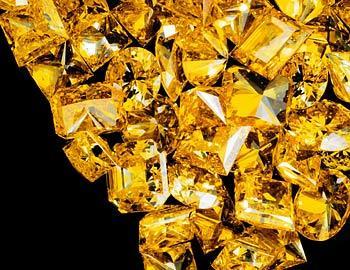Will Mass-produced Diamonds Change the World?
Rich Hua stashed this in Just Plain Cool
Stashed in: Economics!, Florida!, Bling!
Isn't the yellow diamonds' value in their rarity?
Isn't ALL diamonds' value in their rarity?
Diamonds are plentiful! They are controlled in the market by De Beers to increase their value. Rubies, emeralds, tanzanite, sapphires are really much cooler gemstones (IMO) and much more rare, but De Beers brilliantly marketed diamonds with their "Diamonds are Forever" campaign to make them seem more special than they really are.
"Most of the world's diamond market is controlled by just one company: De Beers Consolidated Mines Ltd., which is based in South Africa. Over the years, De Beers has intentionally manipulated the diamond market to its own advantage in several ways. For example, many people don't know that diamonds are actually no rarer than other precious gems, and the stones weren't always so expensive and popular. Demand for diamonds increased directly because of the marketing strategies De Beers used during the 1940s, bearing slogans such as "A diamond is forever." This simply may have been good advertising, but De Beers has also used its dominance within the industry to control the market value of diamonds. The company controls worldwide diamond prices by stockpiling diamonds and releasing only small quantities for sale at a time - - the fewer diamonds that are sold, the higher the prices remain. If the company were based within the United States, this practice could be prosecuted, since it constitutes blatant price fixing. De Beers has also used advertising to control the market value of diamonds by encouraging families to keep their diamonds as heirlooms instead of putting them up for resale."
http://curiosity.discovery.com/question/why-criticism-diamond-industry
Yep, it's a total scam so that one company can make lots and lots of money, basically. Well, that's about to change, it seems. The thing that is actually fascinating to me is the incredible benefit of cheap, mass-produced diamonds for the hi-tech industry.
Diamond, it turns out, is a geek's best friend. Not only is it the hardest substance known, it also has the highest thermal conductivity - tremendous heat can pass through it without causing damage. Today's speedy microprocessors run hot - at upwards of 200 degrees Fahrenheit. In fact, they can't go much faster without failing. Diamond microchips, on the other hand, could handle much higher temperatures, allowing them to run at speeds that would liquefy ordinary silicon. But manufacturers have been loath even to consider using the precious material, because it has never been possible to produce large diamond wafers affordably. With the arrival of Gemesis, the Florida-based company, and Apollo Diamond, in Boston, that is changing. Both startups plan to use the diamond jewelry business to finance their attempt to reshape the semiconducting world.
Is there a difference between industrial diamonds and jewelry?
It seems that it has to do with size. Industrial diamonds generally come in very tiny crystals (dust) while jewelry is comparatively much larger.
Starting in the 1950s, engineers managed to produce tiny crystals for industrial purposes - to coat saws, drill bits, and grinding wheels...General Electric managed to do this in 1954 by using a 400-ton press to crush the hell out of carbon. GE's machine economically produced diamond dust for industrial uses, and by the early 1970s the company had even managed to manufacture stones as large as 2 carats. But that effort took so much time and electrical energy, it was more expensive than buying a mined diamond.
"With the arrival of Gemesis, the Florida-based company ....."
There is hope!
Florida is everywhere!











5:51 AM Aug 09 2013